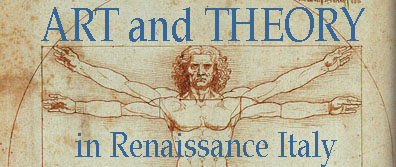|
9 – 10 pages
- The Achievements of the Ancients
Assess the views of Ghiberti and Alberti on the accomplishments of the ancients. Pick out where they mention the antique and examine how they refer to it. What do they admire? Both authors refer to examples of antique sculpture. See what you can find out about these pieces in P. Bober and R. Rubenstein, Renaissance Artists and Antique Sculpture (Oxford, 1986).
 Phyllis Pray Bober and Ruth Rubenstein, Renaissance Artists and Antique Sculpture: A Handbook of Sources (London: Harvey Miller; Oxford: Oxford University Press, 1986): Cochran Library NB85 .B63 1986 Phyllis Pray Bober and Ruth Rubenstein, Renaissance Artists and Antique Sculpture: A Handbook of Sources (London: Harvey Miller; Oxford: Oxford University Press, 1986): Cochran Library NB85 .B63 1986
- The Calumny of Apelles: Lucian, Alberti, Botticelli
Alberti refers to Lucian's description of the Calumny of Apelles as an interesting subject for an "historia." Botticelli appears to have followed Alberti's suggestion. Read Lucian's essay on "Slander" (in Volume 1 of the Loeb Classical Library translation) in which the calumny of Apelles story is recounted, explain its context (who was Lucian and what was he describing?), examine Alberti's interpretation of the same, and finally look to see how Botticelli treats the subject (use Ronald Lightbown’s book on Botticelli). Does Botticelli follow Alberti's description of the subject or Lucian's? How accurate is he?
 Lucian. Translation by A. M. Harmon (Cambridge, Mass.: Harvard University Press; London: W. Heinemann, 1913-1967), vol. 1 (for the dialogue On Calumny): Cochran Library PA 4230 .A25 Lucian. Translation by A. M. Harmon (Cambridge, Mass.: Harvard University Press; London: W. Heinemann, 1913-1967), vol. 1 (for the dialogue On Calumny): Cochran Library PA 4230 .A25
 Ronald Lightbown, Sandro Botticelli, 2 vols. (Berkeley: University of California Press, 1978): Cochran Library ND623.B7 L53 1978b Ronald Lightbown, Sandro Botticelli, 2 vols. (Berkeley: University of California Press, 1978): Cochran Library ND623.B7 L53 1978b
- Alberti and the Composition of the "Historia"
Select a painting executed in the second half of the 15th century in Florence which seems to you to exhibit most completely Alberti's suggestions on composition (paragraphs 35-45). Look through Hartt and Wilkins, History of Italian Renaissance Art for examples of paintings. Artists to look for: Botticelli, Ghirlandaio, Pollaiuolo, Leonardo da Vinci, Filippino Lippi.
 Frederick Hartt and David Wilkins, History of Italian Renaissance Art (Upper Saddle River, NJ: Prentice-Hall, 2011): Ask me for a copy Frederick Hartt and David Wilkins, History of Italian Renaissance Art (Upper Saddle River, NJ: Prentice-Hall, 2011): Ask me for a copy
- Alberti on Light and Colour
Examine Alberti's discussion of light (paragraphs 46-49). Select a painting executed in the second half of the 15th century in Florence which seems to you to follow Alberti's advice. Look through Hartt and Wilkins, History of Italian Renaissance Art for examples of paintings. Artists to look for: Botticelli, Ghirlandaio, Pollaiuolo, Leonardo da Vinci, Filippino Lippi.
 Frederick Hartt and David Wilkins, History of Italian Renaissance Art (Upper Saddle River, NJ: Prentice-Hall, 2011): Ask me for a copy Frederick Hartt and David Wilkins, History of Italian Renaissance Art (Upper Saddle River, NJ: Prentice-Hall, 2011): Ask me for a copy
- Classical Painters
Alberti names several painters of the ancient world: Zeuxis, Apelles, Polygnotus, Timanthes, Aristides, Euphranor, etc. Use Pliny (Alberti's main source - for Pliny, see above, topic no. 2) to identify these painters more fully. What does Pliny say about these painters? What does Alberti say about them (i.e. what does he pick out of Pliny to illustrate the points he wants to make)?
 The Elder Pliny’s chapters on the History of Art, translated by K. Jex-Blake (London, New York : Macmillan, 1896): Cochran Library N5610 .P6 The Elder Pliny’s chapters on the History of Art, translated by K. Jex-Blake (London, New York : Macmillan, 1896): Cochran Library N5610 .P6
- Alberti's Perspective System
Examine Alberti's discussion of the construction of intersection in painting (i.e. perspective), with special attention to how one determines "transverse qualities." This would be a good topic for someone who has a geometrical turn of mind and likes to produce diagrams. A step-by-step illustrated approach to perspective construction following Alberti's description, elucidating the concept and noting problems as you progress.
- "Composition is the procedure in painting whereby the parts are composed together in the picture" (Alberti, On Painting). Discuss
- "I would have the painter first of all be a good man, well versed in the liberal arts" (Alberti, On Painting). Discuss
- "A fifteenth-century painting is the deposit of a social relationship" (Baxandall, Painting and Experience in Fifteenth-Century Italy). Discuss
|



 SCHEDULE
SCHEDULE  REQUIREMENTS
REQUIREMENTS  ART HISTORY GUIDE
ART HISTORY GUIDE

 Phyllis Pray Bober and Ruth Rubenstein, Renaissance Artists and Antique Sculpture: A Handbook of Sources (London: Harvey Miller; Oxford: Oxford University Press, 1986): Cochran Library
Phyllis Pray Bober and Ruth Rubenstein, Renaissance Artists and Antique Sculpture: A Handbook of Sources (London: Harvey Miller; Oxford: Oxford University Press, 1986): Cochran Library